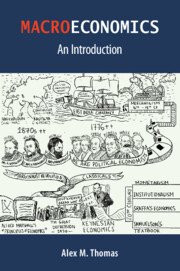Book contents
- Frontmatter
- Dedication
- Contents
- List of Illustrations
- List of Figures
- List of Tables
- Preface
- Acknowledgements
- Note to the Reader
- 1 What is Economics
- 2 Conceptualising the Macroeconomy
- 3 Money and Interest Rates
- 4 Output and Employment Levels
- 5 Economic Growth
- 6 Why Economic Theory Matters
- 7 The Policy Objective of Full Employment
- 8 The Policy Objective of Low Inflation
- 9 Towards Good Economics
- Data Sources
- References
- Index
7 - The Policy Objective of Full Employment
Published online by Cambridge University Press: 08 June 2021
- Frontmatter
- Dedication
- Contents
- List of Illustrations
- List of Figures
- List of Tables
- Preface
- Acknowledgements
- Note to the Reader
- 1 What is Economics
- 2 Conceptualising the Macroeconomy
- 3 Money and Interest Rates
- 4 Output and Employment Levels
- 5 Economic Growth
- 6 Why Economic Theory Matters
- 7 The Policy Objective of Full Employment
- 8 The Policy Objective of Low Inflation
- 9 Towards Good Economics
- Data Sources
- References
- Index
Summary
Introduction
In the previous chapters, we discussed the determinants of output and employment (Chapter 4), the link between economic growth and employment growth (Chapter 5) and, very briefly, the informal nature of employment in India (Chapter 6). As Adam Smith had written, the central objective of political economy is “to provide a plentiful revenue or subsistence for the people”. And the pursuit of full employment is one of the ways through which all the people can secure a ‘plentiful revenue’. Additionally, as already stated in Section 4.1, the employment ought to be secure (reliable) and well-paying (gainful). Together, this can contribute to a good life for all and, therefore, full employment is viewed, in this book, as an extremely desirable policy objective.
This chapter summarises the nature of employment in India by measuring its various aspects—drawing upon, primarily, the context. Recollect from the previous chapter that the ‘what to measure?’ question is heavily dependent on concept (used interchangeably with theory) and context. Subsequently, this chapter reiterates relevant aspects of the Keynesian approach to employment and provides broad-based macroeconomic solutions to tackle India's unemployment problem. The chapter concludes by underscoring the need for a comprehensive employment policy, which meaningfully integrates wages policy, growth policy, agricultural policy and education policy, in order to attain full employment as envisioned here.
The nature of employment in India
There are innumerable ways of looking at employment within the macro, meso and micro approaches. Some of the macro questions we hear take the following form. How much employment has the economy added in the past year? What is the quality of the existing state of employment in the economy as a whole? Do gender and/or caste play a role in determining the overall employment rate? The meso questions are of the following kind. How much employment does the services sector generate every year? What is the extent of distress migration from one sector to another? Do gender and/or caste influence sectoral employment? Questions from a micro approach take the following configuration.
- Type
- Chapter
- Information
- MacroeconomicsAn Introduction, pp. 138 - 162Publisher: Cambridge University PressPrint publication year: 2021

